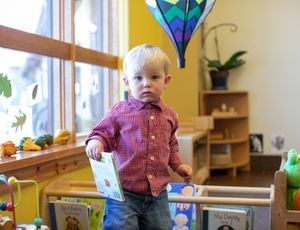Toddlers are attracted to routines and rituals. They find comfort and a sense of safety and security in knowing what will happen next. Hours fly by when we are with toddlers, and most of the time, we believe they need our constant assistance in every part of their day. In this month’s article, we will break down an example of a daily routine for a toddler, and we will pinpoint how we can foster independence during each part of the day.
Toddlers need consistency in their daily activities; it gives them the tranquility of knowing what is coming next, and avoids any anxiety about new transitions. A constant change in their daily routine might overwhelm them and irritate them, impacting the entire routine of the day. Because of this, you must take some time to think about the structure of their day and try to flow as naturally as possible with it. Keep in mind that a daily rhythm or routine is not the same as a schedule. A fixed schedule needs to be followed by the minute, but a routine is flexible and allows the child to take the time he needs before the next part of the routine. A routine feels like a natural and relaxed way to create patterns that will satisfy their need for order.
Here is an example of a daily rhythm for a toddler:
- Wake up
- Play in bedroom
- Use the toilet or change diaper
- Breakfast
- Change clothes, brush teeth and wash face
- Play at home or leave for daycare (if applicable)
- Lunch
- Use the toilet or change diaper
- Nap
- Use the toilet or change diaper
- Play at home
- PM snack
- Get picked up from daycare (if applicable)
- Play at home
- Dinner
- Bath
- Use the toilet or change diaper
- Storytime
- Bedtime
Now, we will break down each part of the day, emphasizing how to foster independence:
Waking Up
Use a low bed instead of a crib. When a child wakes up, he is ready to explore and start the day, and if he is inside a crib, he won’t be able to satisfy his needs without the intervention of an adult. Your child won’t need to cry, scream, or dangerously climb the bars of the crib. He will simply move by himself from the low bed to the shelf with materials or books.
Play in Bedroom
Have a low shelf where he can see all of his options and can reach them. Avoid having too many toys/materials on one shelf because that might overwhelm him and invite him to throw them around the room without any specific goal. If you have a different area for his toys, such as a playroom, avoid having a “baby gate” on the door of his room. The idea is that he can independently use his toys without needing your assistance.
Use the Toilet or Change a Diaper
Provide free access to a bathroom if he is using the toilet, and make sure that he has a stool to reach the toilet, or a small portable toilet he can use. Remember to keep a fresh set of clothes at his reach so he can change in case he needs to. Adding a mirror can help him see if he needs to wipe his bottom again when having a bowel movement. If your child uses diapers, you can leave fresh diapers and a package of wipes so he can grab them and find you to change his diaper. Remember that even if he uses diapers, he can help with pulling up and down his pants and even removing his diaper. If he walks, try changing his diapers standing up so he can collaborate even more.
Breakfast/Dinner/Snack
Assign a place and prepare small plates, forks, and spoons, for him to use. Usually, a lower door in the kitchen or a separate small shelf will work. Consider having a small table and chair so he can set up his table before sitting down to eat. If he is eating fruits with a peel, show him how to peel them and then let him do it. Have a small jug with water or milk next to his open cup so he can refill his cup as needed. Lastly, have a bin where he can place all dirty dishes when done.
Change clothes, brush teeth and wash face
Make sure he has free access to a bathroom. Prepare two outfits for him and let him choose which one he wants to wear, then let him put it on. If you notice your child takes longer to dress than you expect, avoid rushing him. Instead, try to start earlier so he has enough time to do it. Also, make sure the clothes are easy to put on.
Always keep the toothbrush in the same place and have a stool so he can reach the sink.
Leave for Daycare and Pick up
Allow him to carry his backpack (if applicable), put on his shoes, walk to the car, and hop into his car seat. Avoid carrying him in your arms; if he can walk, let him walk.
Nap/Bedtime
Use a low bed. You can sing or tell a story before a nap, but make sure you leave the room calmly after a few minutes. Avoid staying until he falls asleep because that will create a dependency on you being there for him to rest.
Bath
Have all needed items at his reach. Try putting some shampoo in his hands, and encourage him to scrub his head. Then try with the soap, and finally, encourage him to use the towel to dry his body. Have him apply body lotion on his arms, legs, and any part he can reach. Involve him in putting on his pajamas and brushing his hair.
Story Time
Allow your child to choose the book he wants to read, even if he chooses the same one for two consecutive weeks. Read next to him and follow his interests. Allow him to touch, point, and comment on the story. When done, let him put it back in its place.
Every part of the day is an opportunity to connect with your child, and to honor his potential for independence. It takes time, but with consistency, you and he will flow naturally into the same rhythm.
Quote of the Month
“Children are as independent as you expect them to be”
-Maria Montessori
Video of the Month
Montessori at Home: A day in the Life with a Baby and Toddler by the Hapa Family
Watch this 13-Minute video that shows the daily routine of a mom and a girl where she has many opportunities to be independent and participate in the daily chores.
Link to watch it at YouTube:
https://www.youtube.com/watch?v=cIf1qiLV7bk



